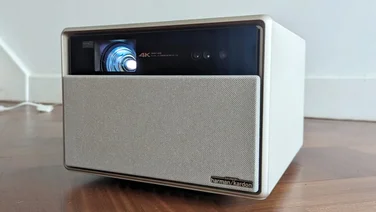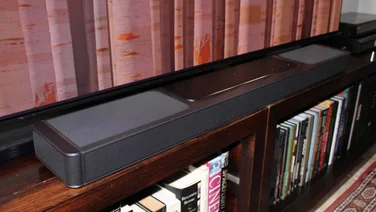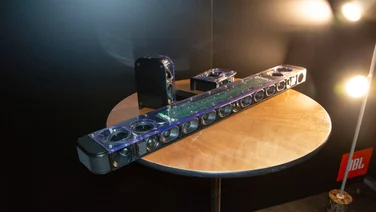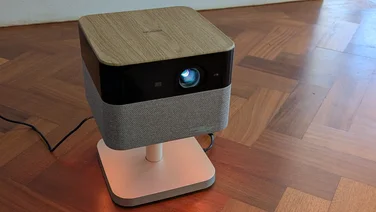To help us provide you with free impartial advice, we may earn a commission if you buy through links on our site. Learn more






















- Accurate Filmmaker and Movie modes
- Low input lag in Game mode
- Tizen is a robust TV OS
- Not very bright
- Disappointing HDR colour volume
- Vulnerable to reflections
We’ve reviewed some incredible Samsung TVs this year. The S95F OLED, Mini LED QN90F and 8K QN900F all scored top marks in our tests and are shining examples of what Samsung is capable of with different panel technologies.
The Korean manufacturer sells more TVs than any other brand globally, so it was no surprise when it scooped the “Most Recommended” gong in our recent TV Brand of the Year Awards. Those awards were based on public opinion, and the Samsung U8000F I’m reviewing here is the kind of TV that average consumers gravitate towards.
It’s one of the most affordable entries in Samsung’s 4K range, available in a wide range of sizes, and is armed with several of the same features as Samsung’s flagship models. But does its performance justify punters’ seemingly undying loyalty to the brand? Let’s find out.
Samsung U8000F: Key specifications
| Screen sizes available | 43in (UE43U8000FKXXU), 50in (UE50U8000FKXXU), 55in (UE55U8000FKXXU), 58in UE58U8000FKXXU), 65in (UE65U8000FKXXU), 75in (UE75U8000FKXXU), 85in UE85U8000FKXXU |
| Panel type | VA-type LCD |
| Resolution | 4K/UHD (3,840 x 2,160) |
| Refresh rates | 60Hz |
| HDR formats | HDR10, HLG, HDR10+ |
| Audio enhancement | 2.0-channel 20W system, OTS Lite, Q-Symphony |
| HDMI inputs | 3 x HDMI 2.0 (one with eARC) |
| Freeview Play compatibility | No |
| Tuners | Terrestrial, cable, satellite |
| Gaming features | Samsung Gaming Hub, ALLM, VRR |
| Wireless connectivity | Wi-Fi 5, Bluetooth 5.3, Apple AirPlay |
| Smart assistants | Bixby, works with Google Assistant and Amazon Alexa |
| Smart platform | Tizen |
What you need to know
The Samsung U8000F sits near the bottom of the most extensive TV lineup in the industry and is designed for those wanting a 4K model that doesn’t cost the earth.
It’s part of the brand’s Crystal UHD range, which also includes the U7000F, and uses Samsung’s Crystal Processor 4K in combination with a basic LCD panel. There’s no local dimming, and although the U8000F supports a handful of Samsung picture and audio enhancement technologies, including Object Tracking Sound and Motion Xcelerator, most of them are inferior versions to those found on the company’s more expensive models.






















HDR support covers HDR10, HLG and HDR10+, but as is the case across the entirety of Samsung’s TV offering, there’s no love for Dolby Vision. The panel’s native refresh rate of 60Hz means high-frame-rate gaming in 4K is off the menu, although the TV does support ALLM and VRR at 60Hz on all three of its HDMI ports.
Price and competition
You can pick up the Samsung U8000F in eight sizes, the smallest of which (43in) will set you back £255. The 50in model is priced at £290, while the 55in option I tested for this review costs £349. The 58in iteration is an Argos exclusive and was available for £359 at the time of writing. The larger 65in, 75in and 85in variants are priced at £499, £699 and £979, respectively.
Similarly priced options can be found in most manufacturers’ rosters, and many of them add a quantum dot filter to the panel to boost colour reproduction. We’ve reviewed a few such tellies over the past 12 months, most recently, the TCL P7K, which impressed John Archer with its sharp 4K pictures. That TV starts at £249 for the 43in, with the other sizes priced as follows: 50in (£299), 55in (£349), 65in (£479), 75in (£599) and 85in (£899).
Amazon has an affordable quantum dot-enhanced TV in the Amazon Fire TV Omni QLED. It’s not available in the larger sizes you can buy the U8000F in, but it’s colour-accurate, supports Dolby Vision IQ, and has Amazon’s Alexa voice assistant built in. The 43in is listed on the retail giant’s website for £290, the 50in costs £360, the 55in model is £410, and the 65in model is £710.
A slightly more expensive option is the Sky Glass Air. Bought outright, the 43in will cost you £309, with the 55in and 65in costing £509 and £649. You can also pay in 24- or 48-month instalments, but you will want to factor in the cost of one of Sky’s TV packages, which start at £15/mth. Picture quality proved impressive when we tested the Sky Glass Air, and my colleague Jonathan Bray also rated its sound and ease of use.
Those looking for something cheaper may want to consider Argos’ own-brand TV: the Bush UTS24SB. Its use of the TiVo operating system means you can enjoy live and on-demand UK TV content via the IP streaming platform, Freely, and it also stands out for its inches per pound spent, with the 55in model available for just £239.
Design, connections and control
As one of Samsung’s cheapest 4K TVs, it’s hardly surprising that the U8000F is not one of its best-looking. The panel is slender enough, however, and doesn’t jut too far out at the back, while the plastic feet it stands on lock into place without needing to be screwed in, making setup an absolute breeze. The feet aren’t height-adjustable, though, and there’s only 50cm of clearance underneath them, which is worth bearing in mind if you intend on placing a soundbar in front of it.






















Like most similarly priced TVs, the U8000F has three HDMI ports rather than four, with one supporting eARC. All three support VRR and ALLM, but since the TV uses a 60Hz panel, the former is less useful than it would be on a TV capable of 4K at 120Hz.
Two of the HDMI ports face directly out of the back of the U8000F, along with an Ethernet port, while the third is right-facing as you look at the front of the TV. There’s also a Common Interface slot, USB-A port and a terrestrial/cable input. Wireless connectivity covers Wi-Fi 5 and Bluetooth 5.3.






















Samsung supplies two remotes in the box: a larger one furnished with a number pad, quick-access buttons for Netflix, Prime Video, YouTube and Samsung TV Plus and various other shortcuts, and a slimmer one stripped back to include the quick-access app buttons and essentials such as volume and channel controls. Neither zapper has an in-built microphone, so if you want to control the U8000F with voice commands via Bixby, you’ll need to do so via the SmartThings app on your smartphone.
Smart TV platform
The U8000F uses Samsung’s proprietary Tizen OS as its smart platform, but you’re not getting quite the same experience as you would were you to buy a model further up the range. The Crystal Processor 4K lacks the grunt to load apps as swiftly, and I found navigation slow at times, with the TV taking a while to respond to my commands. I did, however, enjoy the new take on the quick options menu that pops up when you hit Settings on the remote. Making key adjustments is incredibly simple, and you can do so while continuing to watch what’s on screen, which is nice.






















Tizen is a platform that is rich in content, with all the major streaming services and apps available, including the major UK broadcasters’ catch-up apps. Additionally, you’ve got Samsung TV Plus on hand to deliver free content across over 200 live channels. These include Sky Arts, Sky Mix and plenty of TV show-specific channels such as Pointless UK, Escape to the Country, and Homes Under the Hammer (a personal favourite of mine).
Tizen also integrates Samsung’s SmartThings hub well, allowing you to manage both the TV and any other compatible smart devices you have around the house in one easy-to-access place. You can even create routines to “automate your life”, but while I’m all for increasing efficiency and making things easier for myself, I’m not quite ready to automate my entire existence just yet.






















As mentioned above, there is voice assistant support available from Samsung’s virtual assistant, Bixby, but this takes place through the SmartThings app rather than the TV itself, as it has no far-field mics built in.
Image quality
Samsung has been smashing this area of performance on its flagship screens, but you have to temper your expectations with a TV that’s about as budget as the brand gets. Even then, though, our measurements don’t paint a particularly favourable picture when compared to similarly priced sets from competing manufacturers.
I’ll start with the good news, though: the U8000F is reasonably colour accurate out of the box. It ships in Eco mode, and this returned multi-point grayscale and saturation sweep Delta E errors of 11.7 and 8, respectively.






















I saw a blue tinge to whites, and light blues, purples and reds looked a bit off, but yellows and darker blues tracked their targets closely, and colours were noticeably more accurate at higher saturations. For an out-of-the-box mode, these are solid scores, though well above the target values of under three.
The brightest mode – Standard – returned the same scores but with a tiny bit more luminance, which, as I’ll get to in the HDR section, doesn’t prevent the U8000F from struggling in bright rooms. Still, in a darkened room, the TV does a reasonable job of communicating colours in SDR. The colour palette of animated action series, Blue Eye Samurai, didn’t jump out of the screen, but the U8000F was able to showcase the contrasting cold of snowy scenes and warmth around a blacksmith’s furnace quite effectively.






















Darker scenes evidenced one of the TV’s relative strengths but also one of its weaknesses. Black is uniform across the panel, although not especially deep, and I found it hard to make out much detail in shadowy areas of the picture.
This was true in the U8000F’s Movie and Filmmaker modes, which are dimmer but more accurate. Both returned greyscale and saturation sweep Delta E errors of around 2, with the main difference being picture clarity tweaks to reduce noise and judder in the Movie mode. These are numbers that reflect an excellent ability to reproduce artistic intent. Sadly, unless you’re watching in something approaching a blacked-out room, the panel’s limited brightness means you won’t be able to fully appreciate the U8000F’s talents.






















The U8000F’s upscaling capabilities are pretty good. Lower-resolution sources, such as the channels I mentioned earlier on Samsung TV Plus, gained additional sharpness, though I spotted some softness around the edges of objects and subjects. Motion handling is more of an issue, however. During Match of the Day on BBC iPlayer, the action got a touch blurry at times, rubbing salt into the wounds of watching a dismal away defeat for Newcastle United at the Gtech Community Stadium.
HDR performance
Budget televisions don’t tend to be stellar HDR performers, but brands like TCL have moved the needle by equipping sets like the C6KS with enough brightness to do the format reasonable justice. The 55in model of that TV costs £70 more than the equivalent U8000F but uses a Mini LED backlight and can hit over 1,000cd/m2 in its brightest HDR mode.
The U8000F’s basic LED backlight and lack of any local dimming see it achieve far less impressive luminance numbers. Its brightest mode – Standard – hit 240cd/m2 across the entirety of its panel, which is below the peak figures achieved by other cheap options we’ve tested his year, including the Sharp GM6 (380cd/m2), Bush UT24SB (336cd/m2) and the TCL P7K (330cd/m2).






















What this means is that the TV can be tough to watch in environments where there’s a lot of ambient light. My testing space is one such environment, and watching the U8000F without the curtains drawn was far from an enjoyable experience. The TV isn’t helped by how much external light it reflects. Samsung’s top-of-the-range models have amazing anti-glare and anti-reflection screens, but without these, the U8000F can be a tricky watch in the wrong conditions.
Colour coverage also leaves quite a bit of room for improvement. I measured DCI-P3 coverage at 83%; that’s better than the aforementioned Bush (73%) but well below the Sharp (95%) and TCL (93%). Only 60% of the even wider BT.2020 gamut is covered. There’s still an impressive level of greyscale accuracy on show, however, with my Delta E measurements for Movie and Filmmaker Mode falling below 5, and P3 Sweeps within BT.2020 returning colour errors of under 10.






















You need to factor in a further (albeit very minor) drop in brightness in these modes, though – 230cd/m2 in Filmmaker mode doesn’t really cut it in a bright living room. This leaves the U8000F in a bit of a pickle, and even in darker confines, the lack of any local dimming means that scenes with a broad spectrum of light lack contrast.
The U8000F’s overall HDR performance isn’t hideous; watching a couple of episodes of Mythic Quest on Apple TV+ in Filmmaker mode, I found skin tones naturally reproduced and the overall image reasonably well-balanced, but consistently felt underawed by a lack of vibrancy, impact and low luminance. And, of course, Samsung’s lack of Dolby Vision support means that Apple TV+ content can’t benefit from that HDR format’s metadata.
Gaming
The U8000F’s panel is limited to 4K@60Hz, so serious current-gen gamers should steer well clear. It does, however, keep input lag to an impressive 10.2ms in its Game Mode, and will switch automatically into this when a console is detected, thanks to support for Auto Low-Latency Mode (ALLM). Variable Refresh Rate is supported, too, but given the refresh rate limits of the 60Hz panel, this isn’t as useful as it would be on a more advanced screen.






















Gaming also highlights the picture quality weaknesses described above, with a lack of brightness being the chief culprit. The Game Mode reaches 238cd/m2 across the panel, and greyscale and P3 Sweep errors of above 10 mean you’re not getting an especially accurate portrayal of on-screen action.
Despite this, Ninja Gaiden 4 didn’t suffer too severely when I risked eye strain to play it in a dark room. Hyper realism isn’t the name of the game in a blood-soaked Tokyo infested by demons, so the colour palette’s lack of accuracy didn’t detract from my enjoyment of the flashy Ultimate Technique, obliteration and Gleam attacks. Unleashing Bloodbath Slaughter bathed the screen in a satisfying burst of crimson, and to its credit, the U8000F responded to the insanely fast-paced action well. There was some motion blur at times, but it never became overwhelming, and my inputs were matched on screen in a timely fashion; any missed parries were down to me not having “got gud” enough.






















Unlike pricier Samsung sets, the U8000F doesn’t support the Samsung Game Bar, so you can’t make on-the-fly gaming adjustments, but the Gaming Hub is available and provides access to a range of gaming services, including Amazon Luna, Xbox and Nvidia GeForce Now. You will need a subscription to the services you want to game via, though.
Sound quality
This Samsung U8000F is an above-average but not spectacular audio performer for its price. It doesn’t go incredibly loud, but at moderate volume levels, the soundstage is nicely balanced, with a focus on ensuring that dialogue remains clear. It proved successful in this regard, keeping conversations front and centre during my rewatch of Severance season two.






















Your sound options aren’t as bountiful as you’ll find on some sets, but you can adjust the left and right output, and create a personalised sonic profile using a seven-band graphic equaliser. I found the Adaptive Sound mode worked well for my needs, tailoring the soundstage and frequency levels appropriately to my testing room conditions.
It’s worth noting that the U8000F supports Q-Symphony, so if you own a compatible soundbar from the brand’s extensive range, you can play audio through the TV and bar simultaneously for a more impactful experience. I wouldn’t suggest pairing the U8000F with something like the flagship Samsung HW-Q990F, though, unless you can live with the incongruence of a fully immersive audio experience and a rather less engaging visual one.
Verdict
The Samsung U8000F is a rare TV miss from Samsung. It would be unfair to expect it to perform anywhere near as prodigiously as the brand’s Mini LED and OLED offerings, but the fact is that it’s beaten by similarly priced and, in some cases, cheaper models from other manufacturers.
Samsung’s comprehensive Tizen operating system, good sound and very low input lag are redeeming qualities, but the lack of brightness and disappointing colour coverage mean this entry-level option is one to avoid.
Instead, consider spending between £50 and £100 more (depending on size) on the TCL C6KS, which won our Best Buy award and was described by our man John Archer as “shockingly good value”.







